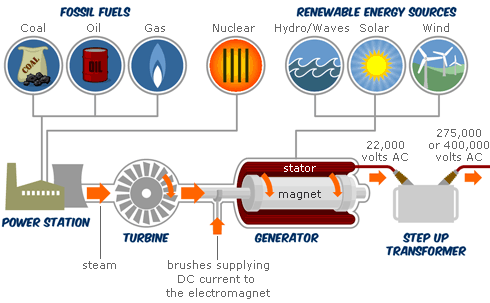Electricity: A Beginner Guide
Electricity is the flow of electrical power or charge. Electricity is a secondary energy source which means that we get it from the conversion of other sources of energy, like coal, natural gas, oil, nuclear power and other natural sources. These energy sources are called primary sources. The energy sources we use to make electricity can be divided in to two basic classes.
- Renewable.
- Non-renewable.
Electricity itself is neither renewable or non-renewable.
Electricity is a basic part of our lifestyle and it is one of our most widely used forms of energy. When many cities and towns first started, they tried to build them alonsite waterfalls, which is a primary source of mechanical enery, that turned water wheels and in turn would eventually create electricity. Before electricity generation began over 100 years ago, houses were lit with paraffin lamps, food was cooled in iceboxes, and rooms were warmed by wood-burning or coal-burning stoves. The principals of electricity gradually became understood when Benjamin Franklin experimented with a kite one stormy night in Philadelhia USA. Thomas Edison, the inventer of the electric bulb , perfected this invention. Prior to 1879, direct current (DC) electricity had been used in arc lights for outdoor lighting. In the late-1800s, Nikola Tesla pioneered the generation, transmission, and use of alternating current (AC) electricity, which can be transmitted over much greater distances than direct current. Tesla's inventions used electricity to bring indoor lighting to our homes and to power industrial machines.
Despite its great importance in our daily lives, most of us rarely stop to think what life would be like without electricity. Yet like air and water, we tend to take electricity for granted. Everyday, we use electricity to do many jobs for us -- from lighting and heating/cooling our homes, to powering our televisions and computers. Electricity is a controllable and convenient form of energy used in the applications of heat, light and power.
We are so accustomed to electricity that we never spare a thought about where it comes from. Now that there is not enough to go round, there is a lot of discussion about what we can do to help.
Most of South Africa's electricity comes from coal burning power stations. The best place to build them is near the coal mines and that's why most are in Mpumalanga. Here in the Western Cape we also have Koeberg which is a nuclear plant as well as some peak power stations that are used to help when the load is very high, there are two gas burning stations and one hydroelectric station at the Steenbras Dam.
The "load" that people talk about is the demand for electricity at any given time, it reaches a peak at about 38 000 Megawatts (MW). A megawatt is a million watts. One watt is not much but the average car produces about 25 000 watts so Eskom produces the same amount of power each morning and afternoon as 1,5 million cars.
But how do they create it?
Electricity is generated by spinning a magnet in side three coils of wire. Each time the magnet passes the wire it generates some electricity. Magnets have two poles and as they swing round the current they generate alternates or moves in opposite directions, this is why our electricity is called Alternating Current (AC). To generate lots of electricity the magnets and coils need to be very big and the problem there is how you turn such a big thing. The thing is called a generator and is driven by stream or water in the case of hydroelectric stations. Power stations work like big kettles boiling water to make steam which drives the generators. The heating either comes from coal crushed into a powder and then blown into a furnace or by the splitting of uranium atoms in a nuclear plant. When the steam is hot enough it is able to make the magnet spin 3000 times a minute or 50 times a second which you may have seen on appliances as 50 hertz (Hz). This is an important number as electrical appliances measure time by counting the direction changes in the current, every 50 switches is one second, however under heavy load conditions the power station can't create enough steam that is hot enough to keep the generators running at 50 spins a second and as a result your clocks slow down.

Where do we store it?
Electricity can't be effectively stored, which is why peak times are so problematic because when you run out, you simply run out. It is the main reason why Eskom forces some people to lose their electric supply. If there were too much or too little electricity flowing in the system it would cause the entire system to crash. This is even more of a problem because it takes time for a power station to start a boiler to create stream for the anticipated loads so they are running almost all the time. This leaves less time for maintenance and so faults are more likely. When faults do occur, they lose the ability to generate electricity and the lights go out.
What can you do then?
Peak times are the real problem, anything you can do before 6am or after 10am in the morning and before 3pm and after 8pm at night will help a lot. Be particularly mindful of things that use plenty of watts of electricity, you can check the watts on any appliances, stoves, kettles, ovens, heaters, geysers or anything that that you use to heat something draw a lot of electricity, use your microwave instead.
Source: Energy for Kids, Wikipedia, Energy.com, Cape Talk.